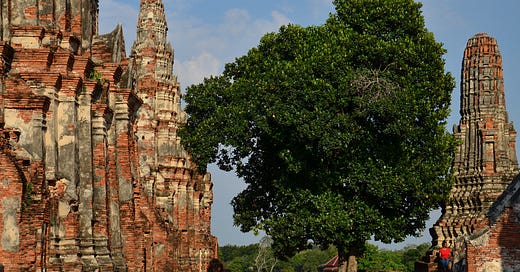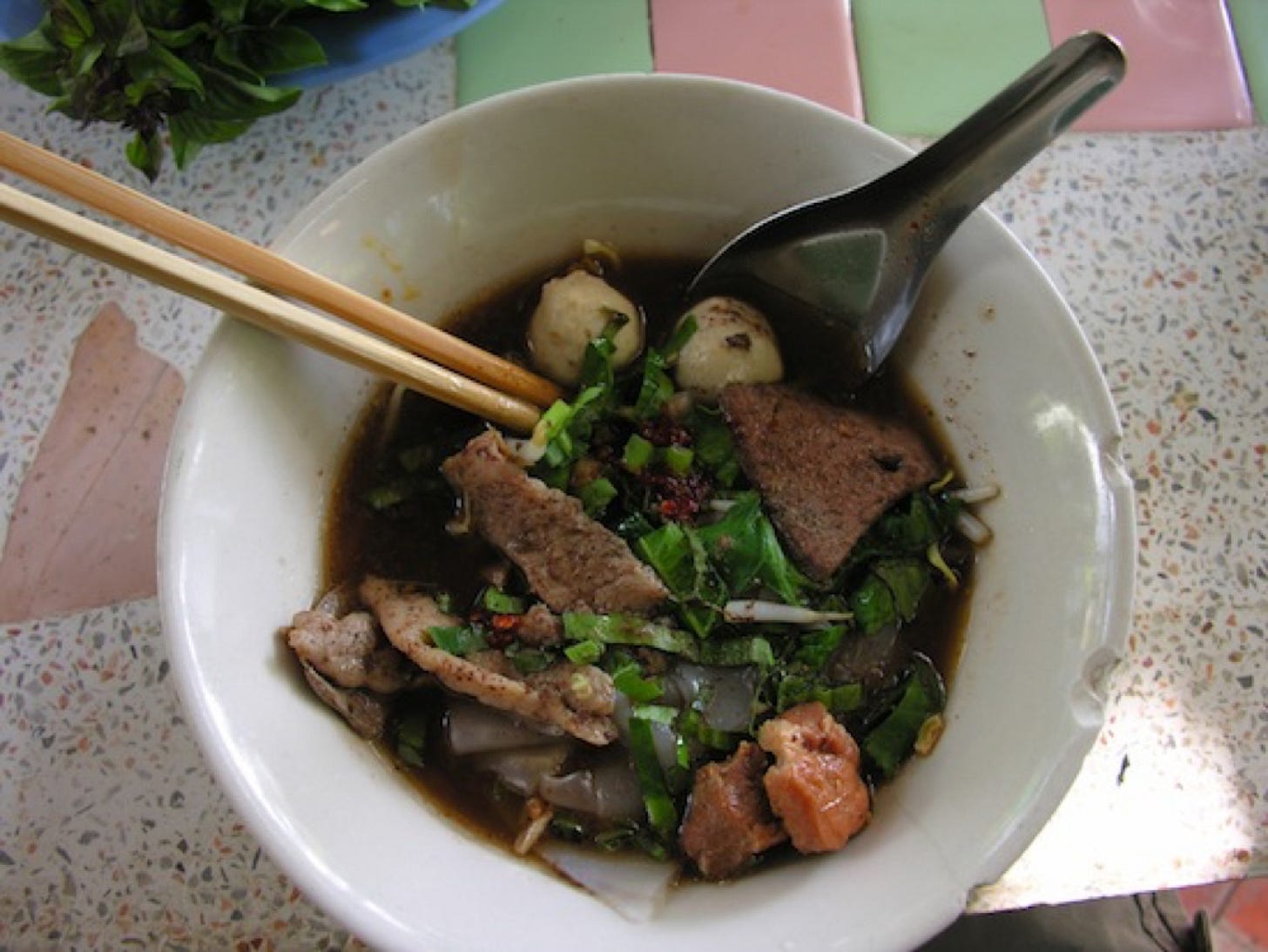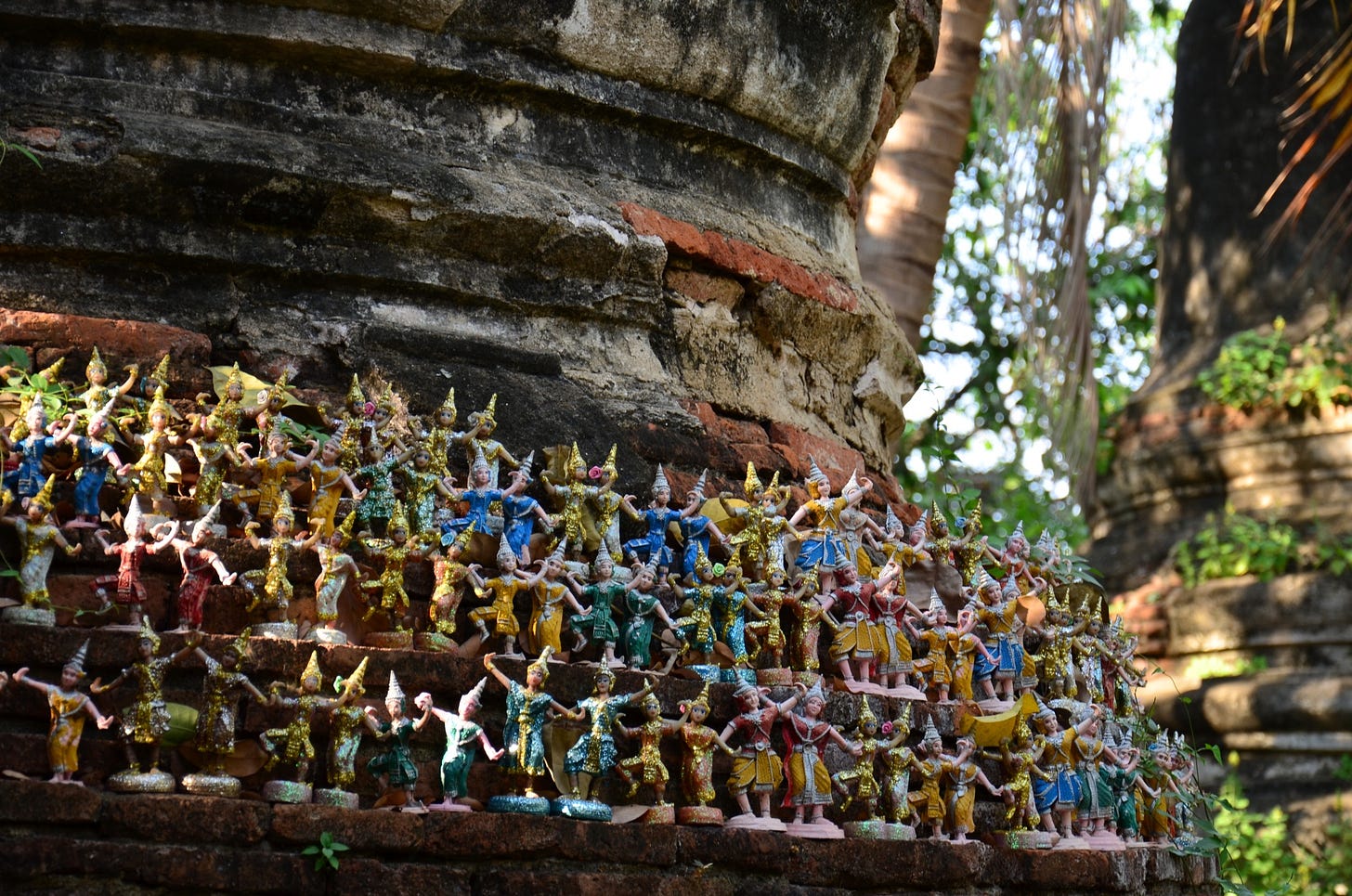Before the Burmese levelled it, Ayutthaya was a thriving trading centre. It wasn’t just Siamese—I like to think of it as a veritable Khao San Road of the 17th century. Holland, Portugal and Japan were all in town along with a diverse Muslim community.
Wandering Wat Chaiwatthanaram. Photo: David Luekens.
Today, ruined pagodas and chedis are the most obvious representation of Ayutthaya’s former glory. However, the understated remnants of these foreign areas remain, and, interspersed with more ruins, make for an interesting day by bicycle.
Enjoying Couchfish? Know a traveller stranded on their couch? Gift them a subscription!
Leaving Baan Lotus in the morning, I ride south to U-Thong Road for breakfast. Kuay tiao ruea’s origins hark back to the Chinese vendors who plied Ayutthaya’s canals back in the day. A delicious bowl of rice noodles immersed in pork broth tempered with roasted pig’s blood, then loaded with shrimp, fish or pork balls and garnished with greenery—what a way to start the day. Sated, I ride four kilometres along the south and west coast to reach a bridge to “Outside Ayutthaya”.
Please let me introduce you to my breakfast. Photo: David Luekens.
Once on the mainland I take a left and head south for the first temple of the day, Wat Chaiwatthanaram. With 120 stucco buddhas, a Khmer-style prang and a riverside setting, I’m starting with an off-island highlight.
Continuing east, I swing by St Joseph’s, then to Wat Phutthaisawan. This is one of the most evocative of the off island temples—and a spot well worth lingering.
Just to the east is the Muslim Quarter. In Ayutthaya’s heyday, Arab, Cham, Malay, Persian and Turkish traders lived, prayed and ate here. With that last activity in mind, I wander off looking for a second breakfast: Roti sai mai—and more coffee.
Beauty comes in all shapes and sizes. At Wat Phutthaisawan. Photo: David Luekens.
East again, to where the Chao Phraya swings south to run towards the ocean. On the bank sits the Portuguese settlement—Baan Portuget. Today, little remains save a small museum and dusty skeletons. Way back when though, Portuguese mercenaries were sought after by the Siamese King. In return for their services and expertise in death and mayhem, tracts of land here were forthcoming. A poisoned chalice perhaps, as the area bore the brunt of the initial Burmese attack that destroyed the city.
Across the Chao Phraya lies the Japanese Village—Baan Yippon. At its 17th century peak there were some 1,700 Japanese living in Ayutthaya. As with their European cross-river neighbours, some were mercenary samurai, many though were Christians freeing religious persecution in Japan. There is a small museum and a pretty Japanese Garden on site.
A display at the museum within Baan Yippon. Photo: David Luekens.
Next off the rank is Baan Hollanda—always early starters, the Dutch set up shop in Ayutthaya in 1608. The museum here does a fine job detailing the activities of the Dutch VOC and next door is a boatyard that was once part of the East India Company’s port.
I leave Holland behind, and ride north to Wat Phanan Choeng. The beautiful temple houses a revered Buddha image and can get busy with devotees. The site predates Ayutthaya and is home to a Chinese community—their cemetery is nearby. Also close by is Kuai Tiao Ruea Ho—yes, more noodles for lunch.
Sated, eastward on to Wat Yai Chai Mongkhon. I can’t miss the enormous chedi, erected to celebrate a Siamese victory over the Burmese in 1592. The ordination hall has a painting of King Naresuan’s elephant-back victory over the Burmese … they got their revenge less than 200 years later.
Wat Yai Chai Mongkhon. Size matters. Photo: David Luekens.
Last stop is Wat Maheyong, a twenty minute bike ride to the north. Here the main attraction is a chedi with dozens of worn elephants around its base. This is the only site like it in Ayutthaya, but it reminds me of what I’ll see in Kamphaeng Phet in a few weeks.
With more time or faster pedalling I could look around the northwest, but I’m done. If you have the energy (or a scooter) David covers that area in his piece on exploring Ayutthaya’s outlying temples.
I could fill the rest of the afternoon with a boat cruise (if you do, keep an eye out for the monitor lizards—always a crowd pleaser for kids), but, to be honest, I’m knackered. Plus for the last hour, I’ve had the fiery Isaan fare of Ban Somtum in the back of my mind. What a coincidence—it’s on the way back to the guesthouse!
Tomorrow, back on the train to head to Thailand’s monkey capital—Lopburi.








I'm also enjoying the posts as well as the commentaries. Looking forward to tomorrow's :)
Really enjoying these commentaries, especially for places I know a little. 👍